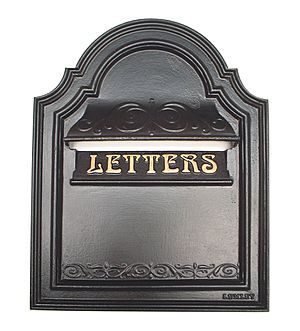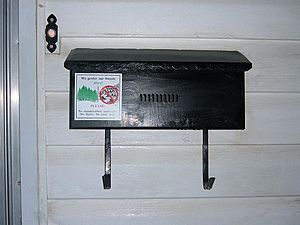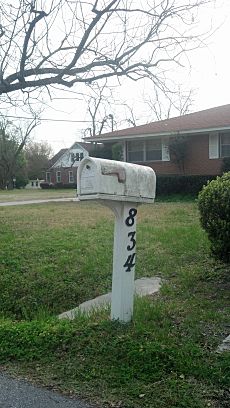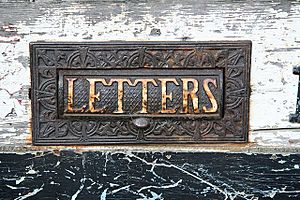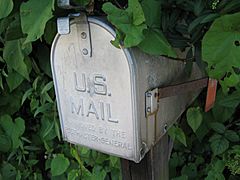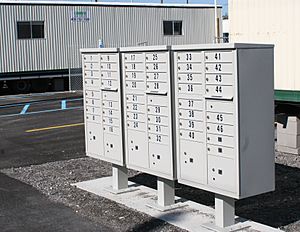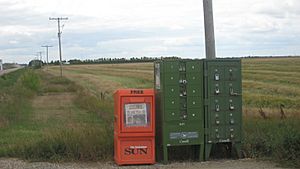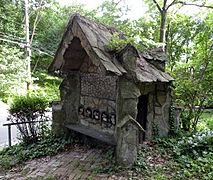Letter box facts for kids
A letter box (also called a mailbox or mail slot) is a special container or opening used to receive mail, like letters and packages, at a home or business. It's different from a post box, which is where you put mail to send it out.
Letter boxes come in a few main types:
- A slot cut into a wall or door where mail is pushed through.
- A box attached right to the outside of a building.
- A box placed near the street, often on a post.
- A central station with many individual mailboxes for everyone in a large building.
- A central station with many individual mailboxes for different homes in a neighborhood.
Contents
Different Kinds of Letter Boxes
Mail Slots

A "mail slot" is a narrow opening, usually about 30 cm (12 inches) long and 5 cm (2 inches) high. It's often found in the middle or lower part of a front door. This type is very common in British homes and offices. In the US, you mostly see them in older parts of some eastern cities.
Most mail slots have a flap on the outside. This flap helps keep out bad weather. Some even have a second flap on the inside for extra protection. Sometimes, a small cage or box is put on the inside of the door to catch the mail. Mail slots are mostly for receiving mail. You usually can't use them to send mail out, as there's no way to keep outgoing mail safe for the mail carrier to pick up.
Wall-Mounted Mailboxes
Wall-mounted or attached mailboxes are boxes fixed to the outside of a building, usually near the front door. These are sometimes called "full-service" mailboxes if they have a way for you to put outgoing mail in them too.
These mailboxes are still used in older city and suburban areas in North America. They are very common in Canada, where you don't often see mailboxes at the street unless you are in a rural area. In the United States, wall-mounted mailboxes are less common in newer neighborhoods. Instead, people often use mailboxes at the street or central mail stations.
Curbside Mailboxes
In rural and some suburban areas of North America, people use curbside mailboxes, also known as rural mailboxes. These are usually large metal boxes on a post near the street. They are designed to hold a lot of incoming mail. Many have a small flag that you can raise to show the mail carrier that you have outgoing mail for them to pick up.
In the US and Canada, rural curbside mailboxes might be grouped together at the edge of properties or at road intersections. The United States Postal Service (USPS) has rules about how far a mailbox should be from the road.
At one time, nearly 843,000 people in rural Canada used these mailboxes. However, Canada Post has since asked many rural residents to use community mail stations instead.
In the US, mailboxes that only receive mail are called "limited-service." Mailboxes that have a way to tell the postman to collect outgoing mail are called "full-service."
Mailbox Rules and Design
Europe
There is a European standard for letter boxes called EN 13724:2002. It suggests things like:
- Mailboxes should be able to receive C4 size envelopes (229 mm × 324 mm) without bending them.
- The inside of the box should be big enough to hold a stack of C4 envelopes at least 40 mm high.
- The opening for mail should be between 230–280 mm wide or 325–400 mm high.
- The opening should be 30–35 mm high.
- The opening should be placed between 0.7 and 1.7 meters from the ground.
- Outdoor mailboxes should not let in much water from rain.
- There are also rules for privacy, preventing theft, resisting damage, and preventing rust.
This standard is not required by law. It was created by a German mailbox company.
Canada
For homes that still get mail delivered to a mail slot, the slot must be at least 17.5 cm by 4 cm. It must be in the front door or a nearby panel, between 60 cm and 125 cm from the floor.
Wall-mounted mailboxes with a slot must have an opening at least 13.5 cm by 4 cm, located near the top of the box.
Curbside mailboxes in Canada (rural mailboxes) must be weatherproof. They need a space for the owner's name and a signal device on the right side (when you face the mailbox) for outgoing mail. This signal device must be visible from a distance and not block the owner's name or traffic. Canada Post requires rural mailboxes to be at least 45 cm long by 17.5 cm wide by 17.5 cm high for rectangular boxes. Round boxes must be 45 cm long by 25 cm in diameter.
United States
The US Post Office has rules for mailboxes, including their size, where they should be, and how they are identified. For a long time, only the traditional dome-shaped or 'tunnel-top' curbside mailboxes were allowed. But in 1978, the US Postal Service (USPS) finally approved "contemporary" designs.
Today, US curbside mailboxes are either Traditional, Contemporary, or Locking. Traditional or Contemporary mailboxes come in three sizes. The largest, No. 3, is about 58 cm long, 28 cm wide, and 38 cm high.
Locking mailboxes, which keep your mail safe, have fewer rules about their shape and size. However, the slot for incoming mail must be at least 1.75 inches high by 10 inches wide. Mail carriers do not have a key to open residential locking mailboxes. This means you cannot send outgoing mail securely from these boxes. The incoming mail slot for locking mailboxes must be 41-45 inches above the road, and the front of the mailbox must be 6-8 inches back from the curb.
Temperature and Mailboxes
Outdoor mailboxes are not temperature-controlled. This can be a problem for things that are sensitive to heat or cold, like medicines, plants, or chocolate. For example, the USFDA found that a black steel mailbox in full sun could reach 58 °C (136 °F) when the air temperature was only 38 °C (101 °F).
Keeping Mail Safe
It's a good idea to have a lock on your letter box if it's not part of a locked door. Unlocked letter boxes can be used by people trying to steal personal information or valuable items. The USPS will not deliver mail to an unlocked or unsafe box at a central mail station.
History of Mailboxes
Europe
Private letter boxes didn't become popular in most of Europe until the mid-to-late 1800s. However, they were used in Paris from the late 1700s.
In 1849, the Royal Mail in Britain started encouraging people to install letter boxes to make mail delivery easier. Before that, similar slots were used in post office walls for people to drop off outgoing mail. An old example from 1809, originally from the Wakefield Post Office, is believed to be the oldest in Britain.
North America
In 1863, the US Post Office Department began delivering mail directly to homes in cities.
Until 1916, mail carriers would knock on doors and wait for someone to answer. This wasted a lot of time. To fix this, the Post Office ordered that every home must have a mailbox or letter slot to receive mail. This rule started around 1912 for new delivery places and became mandatory in 1923.
By the 1880s, the Post Office also encouraged people to attach mailboxes to the outside of their houses instead of using mail slots. These were easier for mail carriers because they didn't have to bend over. They also allowed people to keep outgoing mail dry while waiting for pickup.
To save time when a house was far from the street, it was suggested that mailboxes be placed at the curb on fence-posts or lamp-posts. This idea was rejected for city mail but adopted for rural areas. Curbside mailboxes in rural areas allowed mail carriers to deliver mail to many scattered farms and ranches in one day using horse-drawn wagons or cars.
Before rural free delivery (RFD) started in the US in 1896 (and Canada in 1908), many rural people had to go to a post office far away to get their mail. So, mailboxes only became popular in rural North America after RFD was a regular service. At first, farmers just left empty bushel baskets or tin boxes for mail. It wasn't until 1923 that the Post Office made it a rule that every household must have a mailbox or mail slot.
Curbside mailboxes were first only for incoming mail. But soon, they added a small flag on an arm to signal the postman for outgoing mail. This flag was also used by the postman to tell the resident that mail had been delivered, which was helpful in bad weather.
Since 1923, the USPS has continued to approve the size and features of all mailboxes to ensure mail is delivered easily and quickly. Approved mailboxes are stamped "U.S. Mail" and "Approved by the Postmaster General."
After World War II, many new homes were built in US suburbs. These homes were often larger and on bigger lots, but still used mail slots or wall-mounted mailboxes. This meant mail carriers had to walk much further, slowing down delivery. To make things faster, the Post Office started requiring all new suburban developments to use curbside mailboxes. This allowed mail carriers to stay in their vehicles while delivering mail. In 1978, the USPS said that all new developments must have either curbside delivery or central mail delivery.
The Joroleman Mailbox
In 1915, the well-known curbside Joroleman mailbox was approved. It was designed by Roy J. Joroleman, a Post Office employee. His mailbox had a unique dome-rectangular shape with a curved, tunnel-shaped roof, a latching door, and a spinning signal flag.
The Joroleman mailbox was made of light sheet steel. Its arched roof prevented snow and rain from building up and made it easier to mass-produce. It had a simple latching door and a red signal flag on the side to show if there was outgoing mail. It was designed to be durable and cheap to make. The design was not patented, so any manufacturer could use it. This helped it become very popular. It has been the best-selling mailbox since it was introduced and was also widely used in Canada.
The Joroleman mailbox was first approved in one size, the No. 1, which could hold letters, newspapers, and small packages. After July 1, 1916, it was the only design approved for new curbside mailbox installations. In 1929, larger Joroleman mailboxes, the No. 2 and No. 3, were approved. These could hold bigger packages, which was very popular with rural people who could order goods by mail.
-
Joroleman curbside mailbox with red semaphore flag. When raised, the flag indicates outgoing mail.
South America
On the Galápagos Islands in Ecuador, there's a post barrel on Floreana island that has been used for mail for many years. Since the island is far away, mail delivery can be very slow.
New Mailbox Ideas
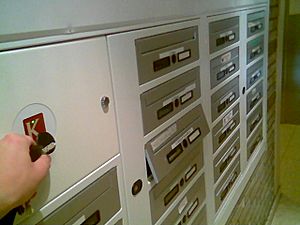
Europe
Sweden
In Falun, Sweden, a housing group called KopparStaden AB has started putting in central mail stations with electronic doors in their buildings.
United States
Many new mailbox designs have been created recently, especially in the United States, with better construction and security. In 2001, the USPS approved locking curbside mailboxes to help stop the increase in identity and mail theft. With these secure designs, the mail carrier puts mail into a slot, and it drops into a locked part. Only the homeowner, who has a key, can get the mail out. Locking mailboxes are usually made of strong steel or aluminum.
Because mailboxes can be damaged, many strong boxes made of plastic or heavy metal have also come out. Some plastic mailboxes can even survive being hit by a baseball bat or run over by a car.
In 1978, because postal service costs were going up, the USPS started requiring new suburban neighborhoods to have either curbside or centralized mail delivery. A study in 1995 showed that delivering mail to a central box was much cheaper than door-to-door delivery.
With centralized mail delivery, a central station with many mailboxes is placed in or near a building or in a neighborhood. These are called group mailboxes, cluster mailboxes, or community mail stations. They are often used in new buildings instead of delivering mail to each door or curb.
Large apartment buildings usually have a group of mailboxes in the lobby or a special mailroom. There's often a special lock box outside that lets the mail carrier into the building. A similar lock is usually on the central mailbox itself, allowing the carrier to open all compartments at once to fill them.
In the US, a property with one address but many mail recipients might use a CBU (Cluster Box Unit). CBUs are usually stand-alone units with locked compartments for each person in an apartment building, mobile home park, or office.
The USPS prefers not to start new door-to-door delivery services. Instead, they now require or encourage builders to install larger NDCBU (Neighborhood Delivery Collection Box Unit) stations in almost all new housing developments. Both CBUs and NDCBUs are commonly called cluster mailboxes. An NDCBU is a central mail station with compartments for delivering mail to many people at different addresses in one neighborhood.
In new housing developments, the builder chooses where the NDCBU goes, not the USPS. It might be far from a person's actual home. These stations usually have a locker for packages and a separate spot for outgoing mail. The mail carrier has a key to a large door that opens all compartments, and residents have a key to their own small compartment.
The location of an NDCBU is very important. If it's in a remote or dark area, it can be a target for large-scale mail theft or damage. Even in busy or gated communities, NDCBUs are tempting targets for thieves looking for checks, cash, or personal information from many people. A study found that NDCBU thefts made up a large percentage of mail thefts in both city and rural areas.
Canada
In Canada, community mailboxes (also called Supermailboxes) started appearing in the late 1980s in newer suburban areas. New developments often get temporary green rural community mailboxes first, which are later replaced with permanent supermailboxes.
Since 2004, many rural Canadian residents have had to use community mail stations (called Community Mail Box, or CMB) instead of individual curbside mailboxes. This change was made to reduce health and safety issues for Canada Post rural mail carriers. This has also been extended to some suburban areas.
Australia
In Australia, people are starting to use Home Parcel boxes. These help deliver packages ordered online, as regular letter boxes are used less due to emails. These boxes often have special locks with changing codes for each delivery, making them more secure from theft.
World Record Mailbox
The largest mailbox in the world is in Casey, Illinois (US). It measures about 162.63 cubic meters. Jim Bolin created it, and it was officially recognized on October 20, 2015.
Gallery
-
A unique mailbox designed by Frederick C. Sauer around 1930 in Aspinwall, Pennsylvania
-
Mailbox of Casa de l'Ardiaca, Barcelona, Catalonia, by Lluís Domènech i Montaner
Images for kids


